Thinking of growing plants through propagation but don’t know what stations or planters to use? Look no further! It won’t matter if you’re new to gardening or an expert. They’re relatively easy to set up and use.
So, what are the best plant propagation stations and planter test tubes? This article will serve as a guide for would-be or expert gardening enthusiasts regarding the best choices of plant propagation stations and planter test tubes, their specifications, how they work, what plants you can put in them, how you can start and use one, and more!
What Are Propagation Stations?
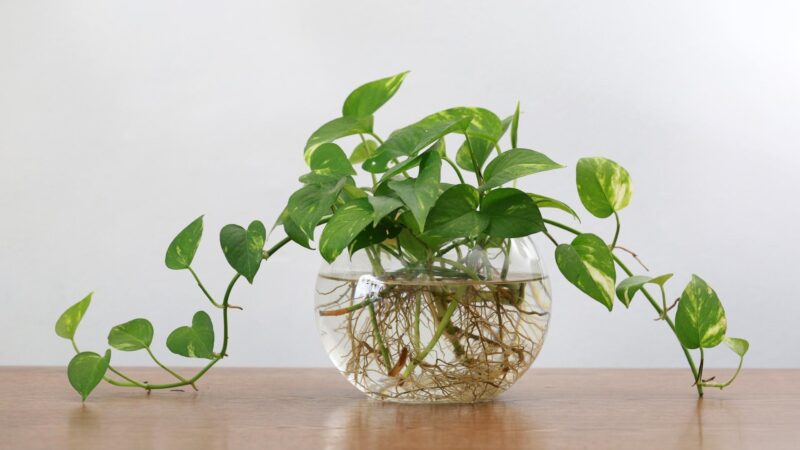
Plant propagation systems are containers that facilitate the process of creating new plants or increasing the number of specific plant species or cultivars. In other words, they are simply media or dedicated areas that you could use to propagate plants.
They can be extensive spaces such as nurseries, greenhouses, cold storage buildings, and outdoor bench spaces created by Harvard’s Arboretum, or they can be as simple as using mason jars, glasses, terrariums, and planter tubes when doing home gardening.
How Does a Propagation Station Work?
Propagation systems work by using leaf or stem cuttings of existing healthy and vigorous plants to grow new plants of the same species. Afterward, they are layered with rooting medium and water depending on the plant’s needs.
They can, then, be placed anywhere you like as long as the plants get a good amount of sunlight and aeration for them to grow into their optimum size and yield. Plant propagation systems can be mounted on walls or placed on flat surfaces.
What Plants Do You Put In a Propagation Station?
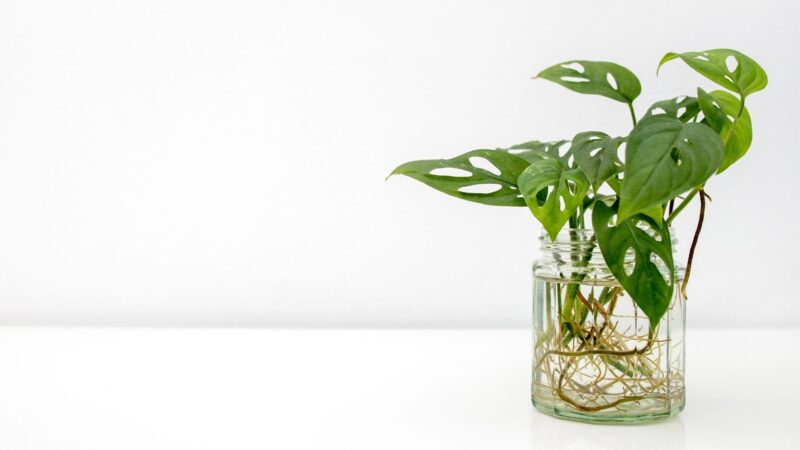
Here are the common plants that you can grow in propagation stations depending on the part of the plant used and where it can be grown:
Plants that can be propagated using stem cuttings:
- African Violet
- Begonia
- Chinese Evergreen
- Geraniums
- Philodendron
- Swedish Ivy
- Poinsettia
Plants that can be grown through leaf cutting propagations:
- Cactus (especially species that produce pads such as Bunnies Ears)
- Jade Plant
- Peperomia
- Swedish Ivy
- Gloxinia
- Snake Plant
- Jelly Bean Plant
Plants that can be rooted in plain water:
- Grape Ivy
- Creeping Fig
- Baby’s Tears
- Fiddle Leaf
- Heart Leaf
- Wandering Jew
- Ti Plant
- Trileaf Wonder
- Christmas Cactus
11 Best Plant Propagation Stations and Planter Test Tubes
Ivolador Wall Hanging Glass Propagation Plant Terrarium
If you desire a simple but eye-catching minimalist design, this rectangular-shaped propagation container is the best choice for you. You can mount it on your walls, desktops, bedside tables, and windowsills, or even use it as a storage holder.
The product is made of high-quality heat-resistant borosilicate glass, which ensures long-lasting usage and is durable against easy breakage. The container has a small hole drilled in its back to allow easy hanging or taking off.
Each package comes with 2 hanging vases and 2 no-mark hooks. However, in the case of the hooks not being functional enough (e.g. they fail at propping up the vases), you can use command strip hooks to hold the products in place.
Product dimensions: 5.9″ (height) x 2.4″ (weight) x 2.4″ (diameter) and weighs 9.6 ounces.
Likemybaby Desktop Bulb Vase For Hydroponic Plants
This bulb-shaped glass vase gives off an aesthetic retro design ideal for home decoration, flower arrangements, gifts to your loved ones, and even party giveaways. It comes with a wooden frame with an attached metal holder to hold the vases securely.
The glass is hand-crafted using high natural light transmission glass, which gives the bulb an overall great quality, smooth surface, and excellent permeability of liquids, fertilizers, and soil.
The wooden stand should be self-assembled using the screwdriver and screws that are included in the package. Unfortunately, the legs of the stand lack non-slip coating, so you would have to apply one to ensure it doesn’t become unstable and wobbly before placing the bulbs.
Product dimensions: The bulb is 9.44″ (length) x 5.11″ (height) while the wooden frame is 5.3″ (height) x 3.9″ (width). The overall weight is 10.4 ounces.
Ivolador Desktop Planter Test Tube Building Blocks
With a unique test tube glass vase design and multi-colored wooden building blocks, these planters can be placed on office desktops or as home decorations. Regardless of where you place them, it’s guaranteed that they will enhance the color of their surrounding environment.
The glass vase is made of high boron silicon glass that is proven to be heat-resistant and not easily broken. However, it’s still a fragile item that should still be handled with care. You can grow a variety of aquatic plants, flowers, grass, miniature ferns, and shrubs in them.
The package is easy to assemble and it comes with 2 tall vases, 2 short vases, 4 long building blocks, 4 short building blocks, a tiny water bead, and a tube brush.
Product dimensions: The long test tube is 6.7″ (height) x 1″ (width), the short test tube is 4.3″ (height) x 1″ (width), the long wooden stand is 2.2″ (height) x 5.5″ (width), and the short wooden stand is 2.2″ (height) x 3.15″ (width). The overall weight is 9.6 ounces.
Laffeya Hydroponic Plant Stand
A simple hydroponics plant holder ideal for flower arrangements, home and office decorations, ornaments, and gifts during special events. It can grow and propagate a variety of plants and flowers, such as geraniums, sunflowers, peace lilies, and African violets.
The package comes with an easy-to-assemble wooden frame, 6 pieces of test tube vases, a cleaning brush, a wooden message board, a wooden push pin, and 2 no-mark hooks. The glass is fragile, so be extra careful when handling it!
For best aesthetic results, place cobbles inside the glass tube to make it more eye-catching. You can also use this product as a container for other liquids.
Product dimensions: each test tube is 7.1″ (height) while the wooden frame is 4.9″ (height) x 1.9″ (width) x 8.7″ (length). The overall weight is 15.5 ounces.
Vumdua Test Tube Plant Propagator Station
These propagation tubes and wooden frame sets provide an elegant design, beautify your personal space, and enhance the vitality of your home or work environment. You may also gift this to your loved ones at special events such as birthdays or wedding presents.
The product is made out of sturdy, high-quality glass and natural wood materials great for propagating small-sized plants. The best feature? No need to assemble! Simply open the package, place your soil and plants, then prop it up on a table or any other applicable surface.
Product dimensions: the narrow test tubes are 0.79″ (diameter) x 4.49″ (height) while the thick test tube is 1.18″ (diameter) x 5.95″ (height). The wooden frame is 6.57″ (length) x 1.5″ (width) x 4.13″ (height).
Mkono Wall Hanging Plant Terrarium
This hanging plant propagation glass is designed with a hexagon shape which makes it a modern and stylish addition for households, offices, and even party decorations. They’re meant to be mounted on walls and can contain a variety of air plants, water plants, and flowers.
The product is created using high boron silicon glass that’s heat-resistant. The package comes with 2 medium-sized glass planters and 2 nail hooks. Each planter has a small hole in them that allows you to properly mount and unmount them on walls.
The manufacturer doesn’t recommend putting fish inside the glass planter as they may not fit in. Hydroponic plants or smaller-sized aerial plants will best thrive in the planters.
Product dimensions: 5.25″ (length) x 2″ (width) x 4.75″ (height) x 1.5″ (diameter) and weighs 0.5 pounds.
Mkono Wall Hanging Glass Planter Propagation Station
Efficient propagators used for cuttings, water plants, and freshly-cut flowers, this 5-test tube glass vase set comes with a wooden rack that can be mounted on walls or simply placed on smooth surfaces, allowing you to decorate wherever you want and save enough space.
The tube planters are made of sturdy, premium quality glass with great permeability for filling and cleaning, while the wooden frame is made out of the natural wood log. Although compactly designed, the glass containers have sufficient space for your small to medium-sized plants.
The package comes with a wooden frame, 5 test tubes with 1 extra, a cleaning brush, and 2 no-mark hooks that serve as its fixtures. It’s easy to assemble both as a standing planter and a planter mounted on walls or windows.
Product dimensions: each test tube is 1″ (diameter) x 6.75″ (height) while the wooden frame is 8.7″ (length) x 2″ (width) x 5.13″ (height). The overall weight is 15.2 ounces.
Ivolador Desktop Glass Bulb Plant Station
A DIY planter with a vintage bulb design and wooden stand so you can propagate your plants, grass, shrubs, creepers, and miniature ferns in style. You can place them on your shelves, desktops, bedside tables, windowsills, and virtually any smooth-surfaced areas!
The package comes with a wooden stand (in 2 separate pieces), 3 glass bulb vases, 8 fixed rubber plugs, a metal swivel holder, a hexagon screwdriver with 2 screws, and an instruction manual.
To set up the wooden frame, simply fit the 2 wooden pieces together and place the metal bar through the holes found on the frame and each of the bulbs. Then, secure each glass with the rubber gaskets and viola! You’re good to go.
Product dimensions: each bulb vase is 4.1″ (height) x 2.6″ (width) x 1.4” (opening diameter) while the wooden stand is 5.5″ (height) x 9.5″ (width) x 4″ (diameter). Overall weight is 0.44 pounds.
Ivolador Terrarium Flower Planters For Hydroponic Plants
The most uniquely-shaped propagation terrariums in this list come in 3 shapes: a diamond, a triangle, and a water drop-like shape. They’re made for hanging in living areas, bedrooms, and offices but can also serve as decor for parties and other special occasions.
The glass is made out of high-quality, heat-resistant boron silicon glass ideal for planting younger and smaller-sized plants. It also comes with 3.3-foot hanging twines and tweezers used to fit into each planter’s holes and then tightly knotted to hang in any place of your liking.
Product dimensions: the water drop is 5.1″ (height) x 3.5″ width), the diamond is measured at 3.9″ (height) x 3.5″ (width), and the triangular-shaped planter is 4.3″ (height) x 3.7″ (width). The overall weight is 9.6 ounces.
VBgree Hanging Glass Planter For Air Plant Propagation
Another fascinating design for hanging glass planters, this product is ideal for displaying your aerial plants, succulents, and other plant cuttings. They add a fresh look and vibe to your walls and kitchen windows or even be the perfect gifts to your nature-loving friends!
The planter package comes with a total of 15 bottle planters, 7 of which are 2 inches in size while 8 are 1.6 inches. It also comes with a long string to tie and knot each bottle and then hang onto your desired surfaces. Take note that the planters can only hold small-sized plants!
Product dimensions: the 2-inch bottles are 0.9″ (diameter) x 0.6″ (opening) while no measurement was given for the 1.6-inch bottles. The rope is 50 inches in length. The overall weight is 14.39 ounces.
Marbrasse Desktop Glass Plant Propagator Hydroponics Vase
This vintage-looking bulb planter is propped on a wooden stand and a metal holder that is designed to resemble a stem and leaves of a plant as well as a miniature bird figure. This is a great decoration for your parties, homes, offices, coffee shops, and gardens.
The glass vase is made of sturdy borosilicate glass, which allows good permeability due to its smooth surface. On the other hand, the stand is artistically created from durable metal and wooden materials.
It’s recommended to start growing a fresh cutting instead of trying to fit your plant with roots that are already established into the vase for an easier gardening experience.
Product dimensions: the vase measures 3.54″ (height) x 2.75″ (diameter). No measurements were provided for the stand. The overall weight is 9.5 ounces.
How to Use a Propagation Station | A Step-by-Step Guide
Step 1: Choose your propagation system or planter product based on where you want to put your plants.
Step 2: Depending on the species you’re going to propagate, prepare the propagation media. Combine the perlite, peat moss, vermiculite, sand, or other materials that can provide drainage, aeration, and moisture for your plants.
Step 3: Moisten the propagating medium by spraying with a mist or placing 1 inch of warm water. Be wary of overwatering! The medium should be moist enough but not too wet.
Step 4: Place the cuttings onto the potting media or water, depending on the type of cutting you’re using:
- For stem cuttings, insert the bare steam into the media.
- For leaf cuttings, a recommended method is to dip the ends into a rooting hormone and insert the stalk into the propagation media.
- When rooting plants in water, just simply place the stem cuttings or leaf cuttings into plain water, then place the propagation system in an area with direct sunlight. You don’t need to use propagation media for this process.
Step 5: After 1 to 5 weeks, depending on the plant, roots should start to form. When their rooting system has been fully developed, transplant the new plants into individual containers with enough growing space.
How Do You Start a Propagation Wall?
Simply purchase a propagation station system or planter test tube product that allows you to hang individual containers with strings and hooks onto a wall. Then, follow the guide above on how to set up and use propagation stations. Make sure you place it in a warm area near a window so that your plants have plenty of direct sunlight.
DIY Propagation Station
Step 1: Choose glass jars or containers that are suitable for planting. They each should have enough growing space for the plant you’re going to propagate. Make sure the jars aren’t enclosed to let the air in.
Step 2: You can choose to use a heavy-duty string or twine to tie and knot the jars, or you can also purchase or build your own wooden or steel frame that could hold the jar in place if you prefer making a standing propagation system instead.
Step 3: After preparing the propagation media and putting the cuttings inside, depending on the plant species, you would be good to go. If you’re using a hanging propagation system, simply mount the jars onto the wall using hooks. Otherwise, place it on smooth, flat surfaces if you’re using a standing system.
Step 4: If you want to add an aesthetic flare to your DIY stations, you can put cobbles or even tiny guppies on the jar if you’re propagating through plain water.
When Should You Propagate Plants?
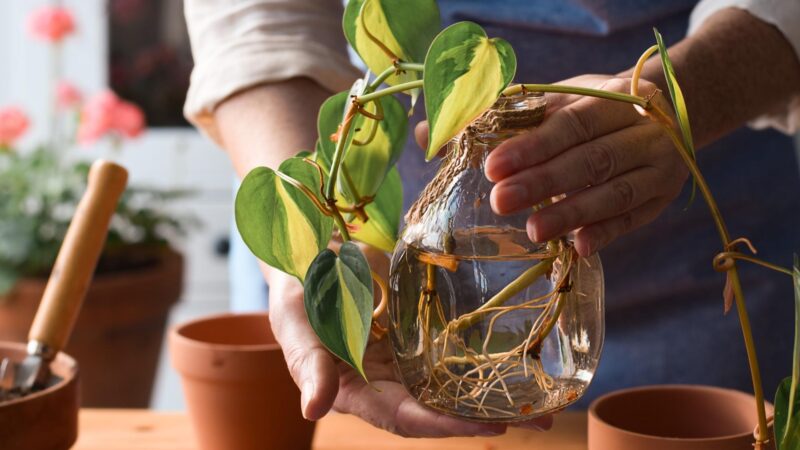
It depends on when you take the cuttings from the source plants. Generally, cuttings should be extracted at the source plant’s peak growth phase, so you should be well aware of this information.
For leaf cuttings, they should be taken around early summer to early fall. For stem cuttings, they should be taken in late fall to late summer, depending on the growth of the plant species. This means that at this period, you should have already prepared your propagation systems and started propagating your desired plants.
Where Is It Better to Propagate: Water or Soil?
It is better to use moist soil when propagating plants as it can facilitate the growth and development of healthy roots. However, it also depends on the plants because there are species that root well and easily in water, such as Christmas Cactus.
Potting mixes are also great media to use, especially soilless potting mixes since they reduce the risk of soilborne diseases and support the development of roots. They are usually a combination of peat moss, perlite or vermiculite, and organic fertilizers or compost.
Can I Put Fertilizer in Water Propagation?
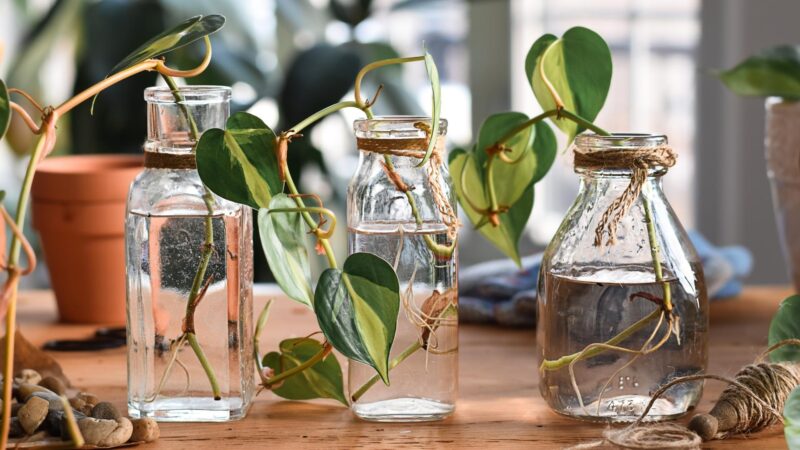
You can put fertilizer in water propagation, but make sure you use water-soluble or liquid fertilizer. It should be applied in small amounts after they start to develop roots. However, most plants that are propagated through water will start growing roots at around 1 to 2 weeks, depending on the plant, regardless of fertilizer application.
Can You Use Rooting Hormone in Water Propagation?
Generally, rooting hormones should not be added to water propagation. They’re usually used for semi-hardwood (tender shoots of woody ornamental plants) and hardwood cuttings (firm and woody), such as thyme and rosemary, that are most likely going to grow well with rooting hormone applied in moist soil and rooting medium.
Do Cuttings Need Light to Root?
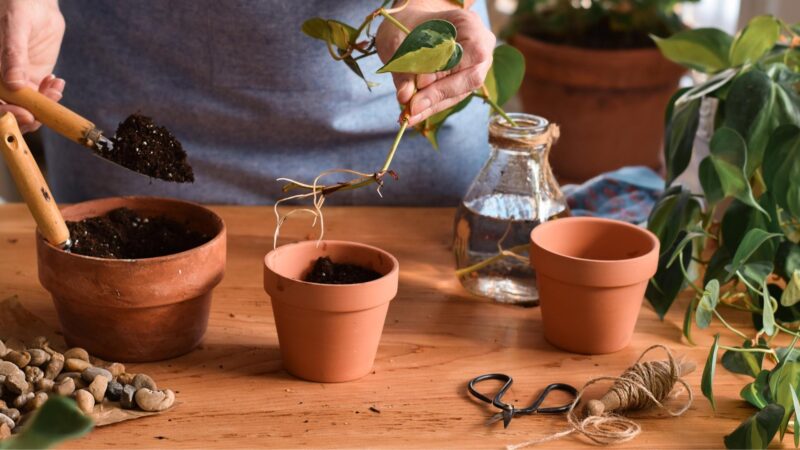
Cuttings need light to root. However, this must be balanced by frequent misting during the first week of propagation, depending on how bright the environment is and how exposed the plants are to light. Too much light will dry out the plants, especially when combined with high humidity. You can stop misting after the roots have started growing, but make sure your plant is still hydrated enough.
What Cuttings Will Root in Water?
Here are the cuttings that will root well in water:
- Grape Ivy
- Creeping Fig
- Baby’s Tears
- Fiddle Leaf
- Heart Leaf
- Wandering Jew
- Ti Plant
- Trileaf Wonder
- Christmas Cactus
Plant propagation systems consist of areas dedicated to the process of creating new plants from existing plants. They work by using leaf or stem cuttings and layering through moist soil or water as well as rooting or potting media then placed on flat surfaces or mounted on walls. Roots should begin formation after 1 to 5 weeks, depending on the plant species.
List of Sources
A Concise Chronicle of Propagation
Basic Techniques for Propagating Plants